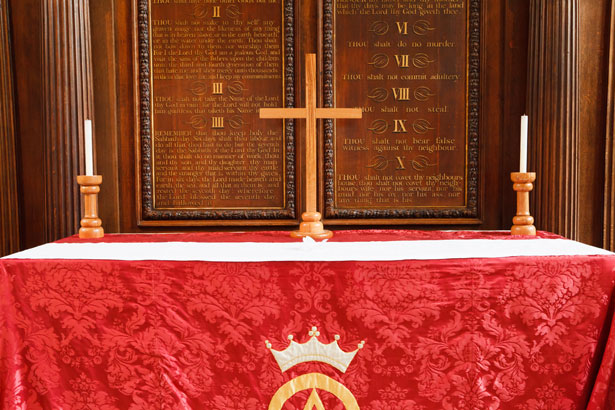A few days ago, I was at daily Mass. While there, I noticed that the woman in front of me was usually a bit slow to stand or sit when the rest of us did and often silent when it was our time to respond. Now, I try really hard not to be distracted by people around me at Mass (read: I am often distracted by people around me at Mass), but I did notice very clearly what she was doing-she was praying a rosary. Since that day, I’ve noticed another five or six times while someone was praying a rosary during Holy Mass.
Now, of course, I love the rosary. What I don’t love is this idea that we can pray the rosary during Holy Mass since we don’t need to be fully engaged at Mass. What I really don’t love is the thought that Mass is the priest doing something and the rest of the Church watching until it is our time to go forward and receive the Eucharist.
If the first time you are paying attention–like really, honestly, paying attention to what is happening–at Mass is when you are walking forward to receive the Eucharist, that’s a pretty good sign that your heart is not ready to receive the Body, Blood, Soul and Divinity of Jesus Christ. If you feel like Mass is about the priest doing something and therefore you can read your book or pray your rosary and just listen to the homily and a couple of other parts of your choosing, you’re missing the point.
Maybe you’ve never seen someone doing this before-I hope not. Probably, though, you have. It seems that at some point this became a normal practice. When we didn’t really know what was happening, or we were bored, we thought that the best way to enter into Mass was to pray some other way, so that at least we were praying. Maybe, you could say, this is a good thing: instead of being bored or struggling to understand the mystery, you are giving the Lord your heart in prayer. The rosary, you might argue, is such a powerful prayer, that it will help us enter into Mass. This, however, is the United States Conference of Catholic Bishop’s (USCCB) General Instruction on the Roman Missal, and I think it disagrees:
“This [the obtaining of the proper fruits from celebration of Holy Mass] will fittingly come about if, with due regard for the nature and other circumstances of each liturgical assembly, the entire celebration is arranged in such a way that it leads to a conscious, active, and full participation of the faithful, namely in body and in mind, a participation fervent with faith, hope, and charity, of the sort which is desired by the Church and which is required by the very nature of the celebration and to which the Christian people have a right and duty in virtue of their Baptism.” (Paragraph 18)
You see, what the Church wants us to hear is this: if you’re going to Mass, your goal is to be fully, actively, consciously participating in what is happening. The priest is offering the sacrifice in the person of Christ, not on his own accord, but through the virtue of his ministry in union with the prayers of the people and the entire Church. When, right at the beginning of the Liturgy of the Eucharist, the priest says “Pray, brethren, that my sacrifice and yours may be acceptable to God the Almighty Father” he is not just saying those words to say them. What he means, literally, is that the sacrifice being offered is the bread and wine, but also the sacrifice of the entire people of God giving their hearts and their entire selves over to Him.
This is why we give an offering right before that moment. Not just because we need money to run a Church (although we definitely do), but because it is a way for people to show that they are giving themselves over to God in this Mass. Even if there is not a collection, this is the time in which we, the people, should offer our hearts to God. When we come to Mass, we are not viewing something, but we are attending a re-presentation of the one sacrifice for all which took place on Calvary. If we are going to truly enter into the sacrifice, we need to sacrifice our own lives in that moment, giving them back to God in a sacrifice of praise, thanksgiving, and worship.
So, I’m not saying you should reprimand the older lady at Mass who is praying her rosary; she probably is simply doing what she has been taught to do. I am saying, though, that I am happy I don’t see this very often. I am very pleased that I see a younger generation of people attending Mass to pray through the sacrifice, not simply because they’re supposed to be there even though they don’t know what’s going on.
When at Mass, we should respond when it is our turn, stand when we are instructed to stand, and focus our hearts and minds constantly on what is happening at Mass, offering our lives to God just as the priest offers the bread and wine as the sacrifice which will be con-substantiated into the very body and blood of God. Keep praying your rosary, but please don’t do it during Mass.






1 thought on “Why I Don’t Pray the Rosary at Mass”
It is interesting. Back in the day, some people prayed the Rosary at Mass, and it is said that they did so because they didn’t understand all that Latin. To make it easier, they put nearly everything in the vernacular. Now, I pray the Rosary during the Mass to drown out the cheesy music, the sermons-in-name-only, and the ‘Liturgy of the Bulletin’ after Holy Communion. It hardly seems to have been worth all the trouble to have made it more ‘accessible’.